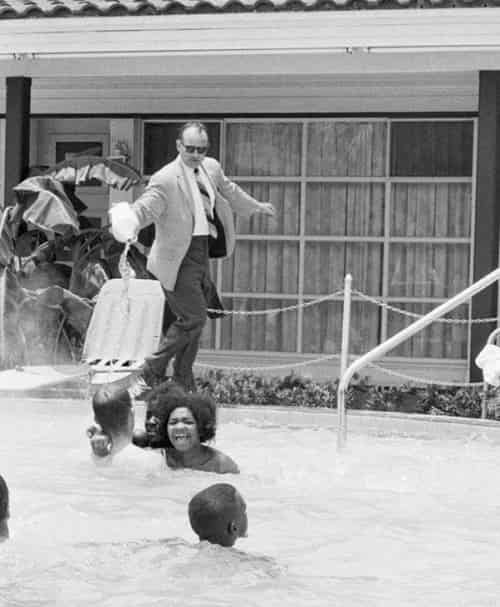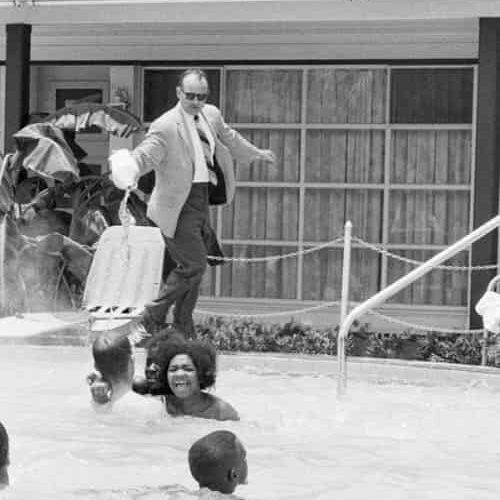The Shocking Story of Acid in a Motel Pool: A Civil Rights Movement Moment

In 1964, a photograph taken by Horace Cort shocked the nation. It showed black and white protesters swimming together in the Monson Motor Lodge pool in St. Augustine, Florida.
This peaceful protest was part of the St. Augustine Movement, a fight against segregation during the Civil Rights Movement. What followed was a shocking act by the motel manager, Jimmy Brock, that would go down in history.
The St. Augustine Movement and Peaceful Protests
The St. Augustine Movement aimed to end segregation in public spaces in the city. St. Augustine, like much of the South, was deeply divided by race. Peaceful protests by civil rights activists were often met with violence. This conflict escalated into larger demonstrations, putting St. Augustine in the national spotlight.
One key event occurred on June 11, 1964, when Dr. Martin Luther King Jr. was arrested for trespassing at the Monson Motor Lodge after being denied service at its segregated restaurant. This act of defiance inspired other activists to take bold actions.
A Pool Becomes the Center of Protest
The swimming pool at the Monson Motor Lodge was labeled “whites only.” To challenge this rule, a group of black and white protesters came up with a daring plan: they would stage a “swim-in” at the pool. On June 18, 1964, black guests were invited by white patrons who had booked motel rooms. Together, they jumped into the pool to protest segregation.
This swim-in was not a random act. It was a carefully planned demonstration led by Dr. King and his associates. They wanted to highlight the unfairness of segregation and draw national attention to their cause.
The Manager’s Shocking Reaction
The motel manager, Jimmy Brock, was furious when he saw black and white protesters in his pool. In a desperate attempt to stop them, he poured muriatic acid into the water. Muriatic acid is a strong cleaning agent, often used for pools or masonry work. While the acid diluted quickly in the water and posed little real danger, the word “acid” struck fear into people.
One brave swimmer, understanding the science behind the dilution, drank some of the pool water to show others that it was safe. Despite Brock’s shocking actions, the protesters remained calm and refused to leave.
Arrests and Violence at the Pool
As tensions grew, law enforcement stepped in. Officer James Hewitt announced that everyone in the pool was under arrest. Officer Henry Billitz, who was off duty, jumped into the pool fully clothed to physically drag the protesters out. He also resorted to beating some of them.
This act of violence, combined with the dramatic image of acid being poured into the pool, drew nationwide attention to the civil rights struggle in St. Augustine. The protest became a turning point in the fight against segregation.
The Civil Rights Act of 1964
The events at the Monson Motor Lodge played a crucial role in pushing for change. Just weeks later, the Civil Rights Act of 1964 was passed. This landmark legislation outlawed segregation in public spaces and employment. It was a major victory for the Civil Rights Movement, but the journey for equality was far from over.
Aftermath for Jimmy Brock and the Monson Motor Lodge
Jimmy Brock’s actions left a lasting mark on his life and his business. Although he was seen by some as a victim of circumstances, his decision to pour acid into the pool haunted him. Fellow motel owner Eddy Mussallem recalled, “Jimmy was a nice guy, but he made a foolish mistake.”
Following the protests, the courts forced Brock and other business owners to integrate their establishments. This angered white supremacist groups like the Ku Klux Klan (KKK). In retaliation, the KKK firebombed the Monson Motor Lodge.
Brock’s troubles didn’t end there. Banks refused to give him loans to repair the damage caused by the protests. He declared bankruptcy the following year. The economic impact of the protests was also felt across St. Augustine. The city, which celebrated its 400th anniversary in 1965, struggled with racial tension and lost millions in tourism revenue.
The End of the Monson Motor Lodge
Despite its historical significance, the Monson Motor Lodge was demolished in 2003 after years of protests to preserve it. A Hilton Hotel now stands in its place, erasing one of the most iconic landmarks of the Civil Rights Movement.
Remembering the Movement
Jimmy Brock passed away in 2007 at the age of 85. His actions, whether driven by anger or fear, became a symbol of the lengths to which people went to uphold segregation—and the bravery of those who fought against it.
The Monson Motor Lodge pool incident remains a powerful reminder of the struggles and sacrifices made during the Civil Rights Movement. It highlights the importance of standing up against injustice, even in the face of fear and violence. Today, this moment serves as a stark lesson in history, reminding us of the fight for equality and the progress still to be made.
FAQ About the 1964 Monson Motor Lodge Pool Incident
1. What happened at the Monson Motor Lodge in 1964?
On June 18, 1964, during the Civil Rights Movement, black and white activists staged a peaceful protest by swimming together in the “whites-only” pool at the Monson Motor Lodge in St. Augustine, Florida. The motel manager, Jimmy Brock, attempted to disperse them by pouring muriatic acid into the pool.
2. Why was the pool protest significant?
The protest was a direct challenge to segregation laws, specifically targeting “whites-only” public accommodations. It highlighted the absurdity and cruelty of segregation, drawing national attention to the civil rights struggle and influencing the passage of the Civil Rights Act of 1964.
3. What is muriatic acid, and why was it poured into the pool?
Muriatic acid is a form of hydrochloric acid commonly used for cleaning pools. Jimmy Brock poured it into the pool, hoping to scare the protesters into leaving. However, the acid diluted quickly in the water and posed no significant danger.
4. How did the protesters react to the acid?
The protesters stayed calm. One swimmer even drank the pool water to reassure others that the acid was not harmful due to its dilution. They remained in the pool until law enforcement intervened and arrested them.
5. Was anyone hurt during the incident?
No one was harmed by the acid, but the protesters faced physical violence and arrests. Officer Henry Billitz, an off-duty policeman, jumped into the pool and used force to remove the swimmers.
6. What role did Martin Luther King Jr. play in this protest?
Dr. Martin Luther King Jr. helped plan the swim-in as part of a larger strategy to challenge segregation in public spaces. He was arrested a week earlier for trespassing at the Monson Motor Lodge’s segregated restaurant, further galvanizing the protests.
7. What were the outcomes of the incident?
The pool protest garnered national attention, contributing to the passage of the Civil Rights Act of 1964, which outlawed segregation in public accommodations. It also exposed the violent resistance to integration in the South.
8. What happened to Jimmy Brock after the incident?
Jimmy Brock faced significant backlash. His motel was firebombed by the Ku Klux Klan, and he struggled financially, eventually declaring bankruptcy. His actions during the protest became a controversial part of his legacy.
9. Why was the Monson Motor Lodge demolished?
The motel was torn down in 2003 to make way for a Hilton Hotel, despite efforts to preserve it as a historic landmark. Its demolition erased a physical reminder of the Civil Rights Movement’s struggles and victories.
10. How did this event impact St. Augustine, Florida?
The protests led to racial tensions in the city, with significant economic consequences. Tourism, a major industry in St. Augustine, declined as the city became associated with violence and unrest during the Civil Rights Movement.
11. What lessons does this incident teach us today?
The Monson Motor Lodge incident underscores the importance of peaceful protest in challenging injustice. It reminds us of the courage of civil rights activists and the need to continue advocating for equality and justice in society.


